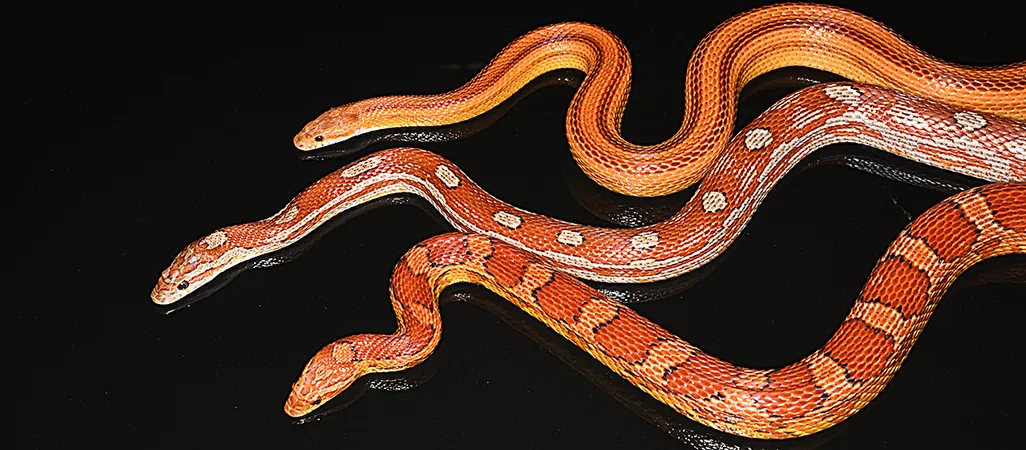
Unlocking Color: One Gene that Defines the Corn Snake's Vibrant Skin Patterns
2025-04-24
Author: John Tan
In the animal kingdom, skin color and patterns are not just for show; they play vital roles in camouflage, communication, and temperature regulation. The corn snake, known for its dazzling morphs featuring red, yellow, and pink blotches, is a prime example of this diversity. But what lies behind these striking patterns?
A Revolutionary Discovery in Genetics
Researchers from the University of Geneva (UNIGE) have uncovered a groundbreaking finding—a single gene, CLCN2, is responsible for these mesmerizing variations in skin patterns. Published in the journal Genome Biology, this study sheds light on the complexities of animal coloration evolution.
The Science Behind the Colors
Corn snakes, or Pantherophis guttatus, display their unique skin patterns thanks to specialized cells called chromatophores, which hold pigments and light-reflecting crystals. Typically, their backs are adorned with red blotches framed by black against a vibrant orange backdrop, complemented by a contrasting black-and-white belly. However, different genetic morphs present a spectacular array of colors and patterns.
Exploring Morphological Variations
Among the fascinating variations are the Motley morph, where dorsal spots fuse or break apart to create linear designs, and the Stripe morph, which boasts uninterrupted stripes. Notably, both morphs share a unique trait of a solid belly, lacking the whimsical checkerboard pattern.
Tracing Patterns Back to CLCN2
Led by Athanasia Tzika and Michel Milinkovitch, experts in UNIGE's Department of Genetics and Evolution, the research team investigated these morphs through crossbreeding and genome sequencing of the offspring. Astonishingly, they traced both phenotypes back to mutations within the CLCN2 gene.
This gene encodes a protein responsible for transporting chloride ions across cell membranes, influencing cellular signaling through ion distribution. Notably, while Motley snakes exhibit variation through reduced gene expression, Stripe snakes possess a transposon insertion that renders the protein ineffective.
Implications Well Beyond Aesthetic Patterns
"These findings were unexpected," say researchers Sophie Montandon and Pierre Beaudier, co-first authors of the study. "In humans and mice, the CLCN2 channel is vital for neuronal function, and mutations can lead to severe conditions like leukoencephalopathy, affecting brain tissues." To further validate the role of CLCN2, the team disabled the gene in corn snakes, leading to Stripe phenotype mutants and confirming its importance.
A New Perspective on Skin Development
To delve deeper, scientists explored where the CLCN2 gene is active within corn snakes. Transcriptomic analyses indicated its expression in both the adult brain and during embryonic development in chromatophores. Studying embryos revealed that mutant chromatophores struggled to cluster, resulting in stripe formations akin to those seen in Stripe morphs.
Asier Ullate-Agote, another co-first author, emphasizes, "While mutations in CLCN2 do not induce neurological or behavioral issues, they play an essential, previously unrecognized role in developing skin coloration patterns." This research not only unravels the genetic threads behind corn snake aesthetics but also opens avenues for understanding color pattern formation in other species.



 Brasil (PT)
Brasil (PT)
 Canada (EN)
Canada (EN)
 Chile (ES)
Chile (ES)
 Česko (CS)
Česko (CS)
 대한민국 (KO)
대한민국 (KO)
 España (ES)
España (ES)
 France (FR)
France (FR)
 Hong Kong (EN)
Hong Kong (EN)
 Italia (IT)
Italia (IT)
 日本 (JA)
日本 (JA)
 Magyarország (HU)
Magyarország (HU)
 Norge (NO)
Norge (NO)
 Polska (PL)
Polska (PL)
 Schweiz (DE)
Schweiz (DE)
 Singapore (EN)
Singapore (EN)
 Sverige (SV)
Sverige (SV)
 Suomi (FI)
Suomi (FI)
 Türkiye (TR)
Türkiye (TR)
 الإمارات العربية المتحدة (AR)
الإمارات العربية المتحدة (AR)